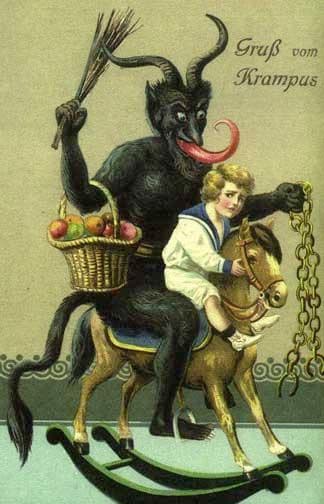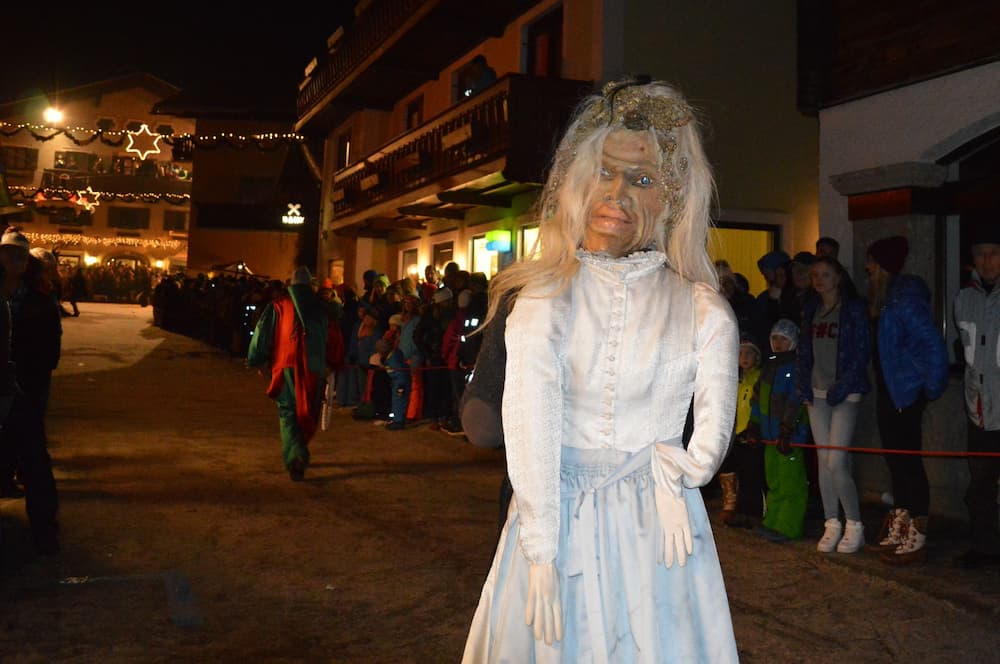First: Avoid Being Chased Down #
I live in Italy and, when I was a child, I didn’t really believe in Santa – I was already asking too many questions. I didn’t mind too much being a good child to receive nice gifts, but a few hundreds of kilometers from me, things were (are!) quite different. In the Eastern Alps, in Austria, Slovenia and other Slavic countries, naughty children are not gifted with black coal by the Befana, as in Italy. In those countries, bad kids are actually hunted down by a horned demon – the Krampus.
Every year, the 5th of December, during the Krampusnacht (“Krampus Night”), men and women march down the street dressed up like demons, with horrifying masks that take the whole year to make. The Krampus Run, or Krampuslauf, is a joyful parade for adults, mostly drunk, but a bit less cherish for children, who are continuously scared and chased by these horrible figures. Large bonfires are lit in the snowy streets as the quiet Alpine villages come to life.
The Krampus is clearly St. Nichola’s counterpart, or Santa’s villain from a modern perspective – a very bad Grinch. He leaves wooden sticks for bad children and takes the meanest with him. Christianity tried to banish these figures and traditions, but in this case, at the end of 19th century, this folklore was rediscovered because of… consumerism. Since when Austrian government quit the monopolisation of postcards, Krampuskarten boomed: Krampus-themed holiday cards filled with dark humor.

“Greetings from Krampus”… isn’t it lovely? I feel like I designed it myself.
Second: Chase the Origins #
As always, the fascinating aspect of this tradition is its origin – even if these are hypotheses and we will never have the absolute certainty. What is sure, though, is that the Percht (female: Perchta) was widely known in the same regions before the Krampus itself. It’s the figure of a woman considered the goddess of the Winter. She has two forms: one is a beautiful young lady white as snow, while the other one is an ugly elderly woman.
The name Perchta may mean “the bright one”, suggesting the lady’s pale skin, but there are also common aspects with the Krampus and the old hag: in historical descriptions, both have two different feet – one human and a larger one, called “goose foot”. Overall, though, Percht-themed masks were already worn during festivals in past times – and this tradition continues nowadays. They reflected the duality of the figure: some costumes were beautiful and bright, while others were horrible horned demons wearing animal furs. Those festivals are still called Perchtenlaufen, probably an earlier form of the Krampus runs.

This costume represents the duality of the Perchta – both beauty and beast… Maybe a bit tending to the latter.
Probably, the Percht evolved in the Krampus after St. Nichola’s introduction. Nowadays, the two shapes may a bit intertwined, but what is interesting is their past. In fact, similarities with the Perchta and other European figures and names can be observed: Bertha, Holda (who also appears in a Grimm’s fairy tale), the Russian Baba Yaga, and even the Italian Befana that I cited before. All these folklore characters, with so many common traits… must have some common roots! This was one of the thoughts fascinating me when I decided to explore our lore.
Third: Connect the Gods Dots #
A simple answer may be also the best one: those were goddesses, or a sort of. All of them were often referred as “guardians of the animals” and, in the form of beautiful women, probably they were Freya. She, Odin’s wife, was often linked to the nature and the animals – she was often identified with boars and cats. Also, the latter ones are a universal symbol for witches. Freya, indeed, was the most powerful sorceress of the whole Norse pantheon; so powerful that she could have been Odin’s teacher regarding magical arts.

Freya by Johannes Gehrts. Note the cats at her feet… they used to tow her chariot!
It is possible that, in Slavic countries, Freya had been a “Winter queen” and then evolved into figures as Holda: the Middle Ages may have shaped her from Norse goddess into a folklore character. But if Freya had been undoubtedly beautiful, why was the Perchta depicted also as an ugly witch?
Short answer: as often happened in the past centuries, probably some roles were mixed. Freya herself is already a notable example of how deities could be merged together – or even split! Frigg, in fact, is another name with which she is referred to in the poems; it is never clear if they are two distinct goddesses and what are the differences between them. One hypothesis is that, at some point, there had been the tendency to split her in two different beings1.
But if Freya had been undoubtedly beautiful, why was the Perchta depicted also as an ugly witch?
Another resemblance with Norse mythology is again about the Krampus, maybe inherited from the Percht: it is told to be the son of Hel, the ruler of the homonymous world, the Land of the Dead. Hel was one of Loki’s daughters2 and she was portrayed with a gloomy appearance. Her name means “the hidden one” – do you know which name could have the same meaning, according to the Old German language? Percht, that’s correct!
It’s not over yet: it is told that the Perchta howled in the woods in winter nights, as the Wild Hunt did, and lived in the elderberry bush, which is often linked to Freya. The list of common features could be so much longer! But of course (it is mandatory to remind that) all of these are thesis with no “real” proofs. I feel so heavy-hearted when I think about all that past knowledge that we won’t be able to recover.
What is certain, though, is that today is the 5th of December, and tonight the Krampus will run through the snowy streets of small rural Alpine villages, chasing down children – and it will happen again next year, and the next, and the next…

That glance… Enough said. Children, beware! 👀
-
Unfortunately, we have only relatively “modern” poems of Norse mythology since, until less one thousand years ago, those stories were retold verbally and with rock carvings. ↩︎
-
Loki had offspring as father… but as mother too! Did you know that he gave birth to an eight-legged horse? We’ll talk about that. ↩︎